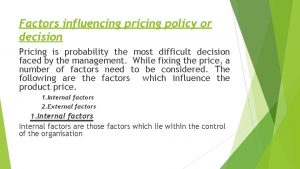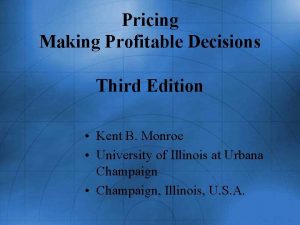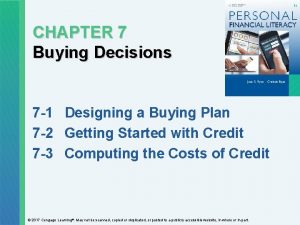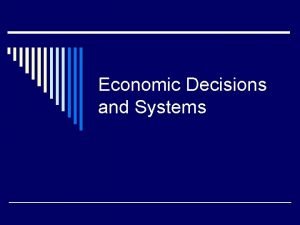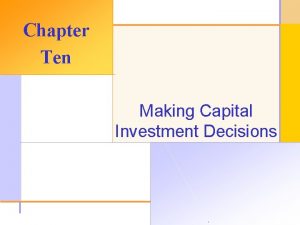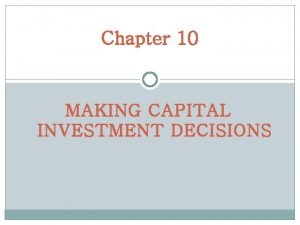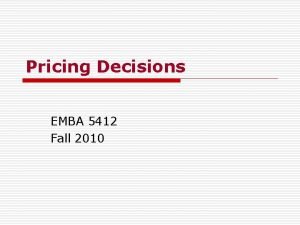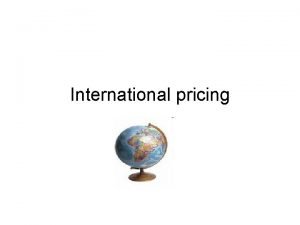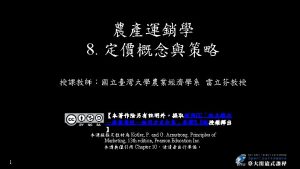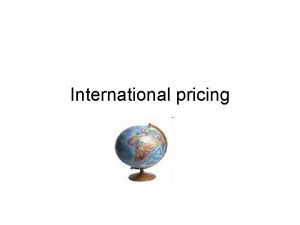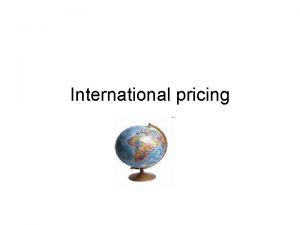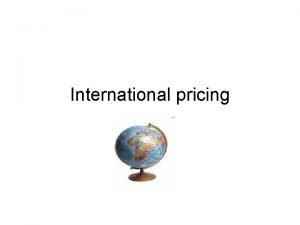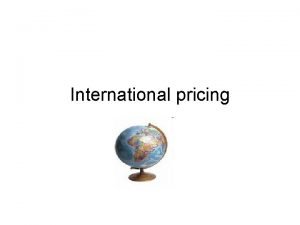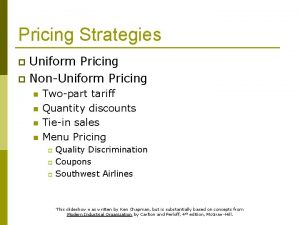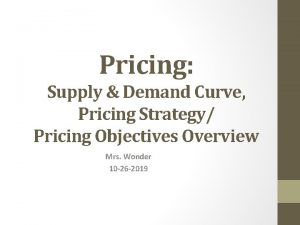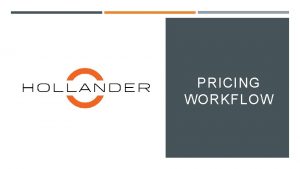Chapter 11 Pricing Decisions Mc GrawHillIrwin Copyright 2010






























- Slides: 30

Chapter 11 Pricing Decisions Mc. Graw-Hill/Irwin Copyright © 2010 by The Mc. Graw-Hill Companies, Inc. All rights reserved.

A Process for Making Pricing Decisions • Price approaches should consider: – The business strategy and the other components of the marketing mix with which it must be compatible. – The extent to which the product is perceived to differ from competitive offerings in quality or level of customer service. – Competitors’ costs and prices. – Availability and prices of possible substitutes. 11 -2

A Process for Making Pricing Decisions • Strategic pricing objectives should reflect what the firm hopes to accomplish with the product in its target market. 11 -3

A Process for Making Pricing Decisions • Maximize sales growth – – – An early entrant into a new product-market with the potential for growth, may look to maximize its product’s rate of sales growth. It should set a relatively low price to attract as many new customers as quickly as possible. This low-priced strategy is called penetration pricing. 11 -4

A Process for Making Pricing Decisions • Maintain quality or service differentiation – When a firm has a strong competitive position based on superior product quality or customer service, its primary pricing objective is to generate sufficient revenue to maintain that advantage. – Set price relatively high to cover high production, distribution, and advertising costs. – Set price high to reinforce prestige image. 11 -5

A Process for Making Pricing Decisions • Maximize current profit: Skimming – Skimming price policy: Setting the price very high and appealing to only the least pricesensitive segment of potential customers. • Maximize current profit: Harvesting – Attempts to maximize short-term profits before demand for the product disappears. 11 -6

A Process for Making Pricing Decisions • Survival – Adopted when the businesses run into trouble because of strategic mistakes. – The pricing objective is to keep the product alive, with a low price, while strategic adjustments are made. • Social objectives – Offering a low price to customers to achieve some broader social purpose. – Common among not-for-profit organizations. 11 -7

A Process for Making Pricing Decisions • Estimating demand perceived value – The inverse relation between a product’s price and the quantity demanded: the higher the price, the less people want to buy. – Thus, the typical demand curve has a negative, or downward, slope. – Prestigious products and those whose quality is difficult to objectively judge sometimes have positively sloping demand curves. 11 -8

A Process for Making Pricing Decisions • Factors affecting customers’ price sensitivity – – – Buyers’ willingness to pay a given price is influenced by their perceptions and preferences. The price, availability, and attractiveness of alternative brands and substitute products. The size of their incomes relative to the price influences customers’ ability to pay for a product or service. 11 -9

A Process for Making Pricing Decisions • Price Elasticity of Demand – – The degree of responsiveness of demand to a price change. Elastic Inelastic Unitary 11 -10

A Process for Making Pricing Decisions • Methods for Estimating Demand – – Survey a sample of consumers, or bring them into a laboratory setting, and ask them how much of the product they would buy at different possible prices. Other approaches include estimating the price –quantity relationship, in-store experiments or multiple test markets. 11 -11

A Process for Making Pricing Decisions • Estimating Costs – Fixed costs (or overhead) are constant in the short term, regardless of production volume or sales revenue. – Fixed cost per unit declines as a firm produces and sells more of the product in a given period. – Variable costs vary in magnitude directly with the level of production, but they remain constant per unit. 11 -12

A Process for Making Pricing Decisions • Estimating costs – Total costs equal the sum of fixed and variable costs for a given level of production. – Marketing mix costs must also be considered. • Measuring Costs – The firm’s cost accounting system. – Activity-based costing systems. 11 -13

A Process for Making Pricing Decisions • Cost and volume relationships – Economies of scale – The experience curve 11 -14

A Process for Making Pricing Decisions • Analyzing competitors’ costs and prices – The manager needs to learn and track the price, cost, and relative quality of each competitor’s offer. – Reverse engineering can be used to take apart competing products and estimate the cost of their components, packing, and production processes. 11 -15

Methods Managers Use to Determine an Appropriate Price Level • Cost-oriented methods – Adding a standard markup to the cost of the product. – Rate-of-return, or target return, pricing brings the cost of capital tied up in producing and distributing the product into the decision. – The impact of variations in volume can be examined by preparing a break-even analysis. 11 -16

Methods Managers Use to Determine an Appropriate Price Level • Competition-oriented methods – Firms try to control costs to make adequate returns at prices consistent with competition. – Going-rate, or competitive parity, pricing approach: Maintaining prices equal to those of one or more major competitors. – Prices are usually stable in industries until a price leader decides an increase in prices is required. 11 -17

Methods Managers Use to Determine an Appropriate Price Level • Competition-oriented methods – Discount or premium price policies – Sealed bidding – Expected value model – Internet auction sites make accurate cost estimates more critical. – Seller’s auctions and buyer’s auctions 11 -18

Methods Managers Use to Determine an Appropriate Price Level • Customer-oriented methods – Pricing to capture the value perceived by the customer. – Estimating customer value by assessing value -in-use. – Difference between the value perceived by the customer and the manufacturer’s marginal cost defines the range of possible prices. – Single customary price, price lining, psychological pricing and promotional pricing. 11 -19

Deciding on a Price Structure: Adapting Prices to Market Variations • Geographic adjustments – In FOB origin pricing, the manufacturer places the goods “free on board” a transportation carrier. – At this point, the title and responsibility passes to the customer, who pays the freight from the factory to the destination. – In freight absorption pricing, the seller picks up all or part of the freight charges. 11 -20

Deciding on a Price Structure: Adapting Prices to Market Variations • Geographic adjustments – In uniform delivered pricing, a standard freight charge is assessed every customer, regardless of location. – In zone pricing the company divides the country into two or more pricing zones. 11 -21

Deciding on a Price Structure: Adapting Prices to Market Variations • Global adjustments – Prices in different countries may have to be adjusted for: • • • Transportation costs. Exchange rates. Variations in competition. Market demand, or strategic objectives. Different governmental tax policies or legal regulations. 11 -22

Deciding on a Price Structure: Adapting Prices to Market Variations • Discounts and Allowances – Trade Discounts – Quantity Discounts – Cash Discounts – Allowances – Price-Off Promotions – Coupons, Rebates, and Refunds 11 -23

Deciding on a Price Structure: Adapting Prices to Market Variations • Differential Pricing – Occurs when a firm sells a product or service at two or more prices not determined by proportional differences in cost. – Common adjustments include: • Location pricing. • Time pricing. • Customer segment pricing. 11 -24

Deciding on a Price Structure: Adapting Prices to Market Variations • Product-line pricing adjustments – Required when a firm produces a line of several models that customers perceive as bearing some relationship to one another. – A cross-elasticity is the percentage change in sales of one product induced by a 1 percent change in the price of another product that is assumed to be a close substitute. – Bundling 11 -25

Take-Aways • Pricing decisions involve an inherent conflict between: – The need to win customers by allowing them to retain a portion of the value inherent in a product or service and – The need to maintain profit margins sufficient to compensate employees, fund growth, and satisfy the firm’s various stakeholders. 11 -26

Take-Aways • The price of a good or service must be high enough to cover per unit costs—at least in the long term—but cannot exceed its value as perceived by the customer 11 -27

Take-Aways • The decision about what price to select from within the range of feasible prices should be based on a careful analysis of: – Competitors’ costs and prices, – The product’s strategic objectives, and – Consistency with other components of the marketing plan. 11 -28

Take-Aways • Perhaps the key concept in setting a price is the notion of perceived value. 11 -29

Take-Aways • The final step in deciding what price to charge for a product or service involves the development of a price structure that adapts the price to variations in cost and demand across geographic territories, national boundaries, customer segments, and items within the product line. 11 -30
 Image making meaning
Image making meaning Screening decisions and preference decisions
Screening decisions and preference decisions Pricing policy
Pricing policy Pricing and output decisions in perfect competition
Pricing and output decisions in perfect competition Pricing decisions and cost management
Pricing decisions and cost management Pricing: making profitable decisions
Pricing: making profitable decisions 2010 pearson education inc
2010 pearson education inc C-929-a
C-929-a Copyright 2010
Copyright 2010 Copyright 2010 pearson education inc
Copyright 2010 pearson education inc Copyright 2010 pearson education inc
Copyright 2010 pearson education inc Copyright 2010
Copyright 2010 Nwoz
Nwoz Copyright 2010 pearson education inc
Copyright 2010 pearson education inc Copyright 2010 pearson education inc
Copyright 2010 pearson education inc Copyright 2010 pearson education inc
Copyright 2010 pearson education inc 2010 pearson education inc
2010 pearson education inc Copyright 2010 pearson education inc
Copyright 2010 pearson education inc Composition copyright example
Composition copyright example Copyright 2010 pearson education inc
Copyright 2010 pearson education inc Chapter 4 financial decisions and planning
Chapter 4 financial decisions and planning Chapter 4 financial decisions and planning
Chapter 4 financial decisions and planning An organized method for making good buying decisions
An organized method for making good buying decisions An organized method for making good buying decisions
An organized method for making good buying decisions Chapter 10 personal loans and purchasing decisions
Chapter 10 personal loans and purchasing decisions Chapter 1 economic decisions and systems answer key
Chapter 1 economic decisions and systems answer key Cca formula
Cca formula Chapter 4 financial decisions and planning
Chapter 4 financial decisions and planning Chapter 4 financial decisions and planning
Chapter 4 financial decisions and planning Chapter 4 financial decisions and planning
Chapter 4 financial decisions and planning Nwc change
Nwc change


